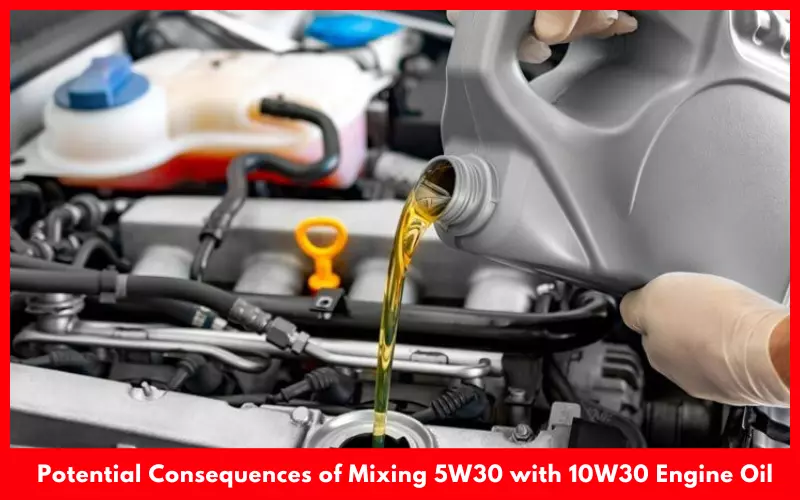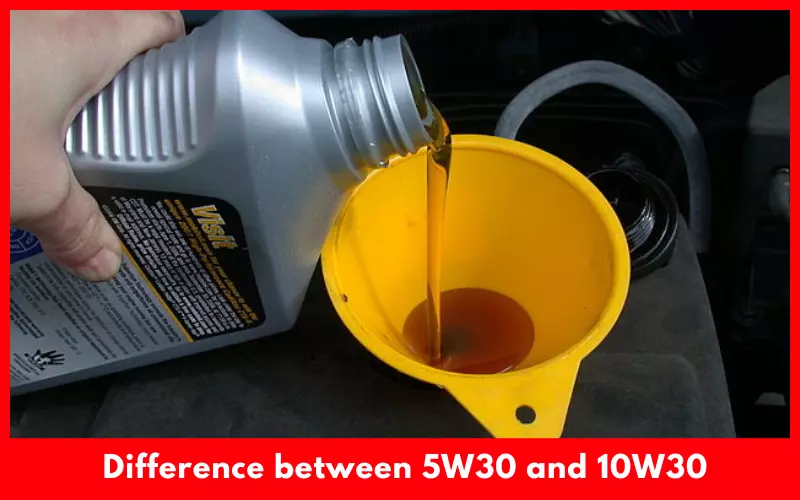Do you have some leftover 10W30 engine oil and planning to mix it with 5W30 to save some bucks? Will it be a good decision for your engine? Can you mix 5W30 and 10W30? Yes, you can. mix 5W30 and 10W30. But it isn’t necessarily ideal as both oils flow at different rates due to their different temperature endurance.
Basically 5W30 grade engine oil perform well at low temperature and 10W30 at medium temperature. If you need to mix 5W30 and 10W30 in an emergency, use some additives and put the lighter one first.
Article Summary
Can you Mix 5W30 and 10W30?
If your car’s manufacturer recommends 10W30, you can mix some 5W30 engine oil on it. In warm climates, the mixture of 5W30 and 10W30 will act quite similar since both have the same viscosity at operating temperatures.
But if your car manufacturer recommends 5W30, using this mixture won’t pump properly at very cold temperatures. If you’ve already mixed 5W30 and 10W30 as an accident or as a result of outright ignorance, don’t worry. Your engine will survive till the next oil change.
However, you mightn’t get the desired output by mixing these two oils. 5W30 engine oil is lighter and has less density while 10W30 is a higher grade and has more density.
One common purpose of planning to mix 5W30 and 10W30 is to get thicker oil. But mixing 5W30 and 10W30 will still provide you a 30 weight at operating temperature. So this experiment won’t be helpful. Instead, you can mix 10W40 with the 5W30 following a 50-50 ratio to get thicker oil.
Potential Consequences of Mixing 5W30 with 10W30 Engine Oil
Mixing 5W30 and 10W30 won’t hurt your vehicle immediately but can reduce the engine’s performance and shorten the oil-changing interval.
The reason is that these oils have different additives which won’t let them blend properly. Using a mixture of 5W30 and 10W30 can also affect the proper flow during the cold season.

10W30 engine oil is also thicker than 5W30, making it better for carrying heavier loads and use during colder temperatures. But in warmer climates, thinner oil like 5W30 is more beneficial as it can provide more lubrication. But mixing these two grades won’t let them do their job properly.
The 5W oil has a different hydrocarbon molecular structure than the 10W type. So if you mix 5W30 with 10W30 engine oil, it’ll cause out-gassing. The hydrogen’s out-gassing can dry out the engine’s valve seals and collapse the hydraulic lifters.
Warranty is another crucial consideration. If your car’s manufacturer suggests using only the 5W30, they’ll void the warranty if they notice different grade oil in the engine.
Can you Put 10W30 instead of 5W30?
If you add a little amount of higher viscosity oil than the recommended, nothing should happen to the engine. The crankcase’s engine oil won’t be affected. But if you replace the recommended 5W30 with the 10W30, it’ll reduce the engine’s longevity and increase the wear of some expensive components. This change will also slightly reduce the car’s miles-per-gallon performance.

Modern car engines are designed to accept particular lubricants. A modern engine with chain tensioners and a VVT system needs specific oil pressure to run properly. 5W30 engine oil is a good option for an area with 100F ambient temperature. Though 10W30 won’t cause any problem in 100F+ weather on a cold start, it won’t benefit the engine as well.
Instead, you can notice a bit of cam phaser noise in the car engine on cold starts as 10W30 can take slightly longer to reach the engine’s top than 5W30.
If you accidentally put some 10W30 on an engine that suits 5W30, keep driving till the next oil change. In this case, you’ll have some quarts of 5W30 and a quart of 10W30 they never mix.
So don’t use an oil that has different viscosity and stick to the oil that is specified by the manufacturer.
Difference between 5W30 and 10W30
Below we’ve discussed some key differences between 5W30 and 10W30 engine oil to help you realize the effect of mixing or using one instead of the other:

Design Purpose
Both grades of oil are similar in terms of their second number. But the difference is in the first number before W. At below-freezing temperature, 5W30 engine oil will be thinner than 10W30 engine oil.
5W30 oil is intended to work effectively at 30 to 35°C. so this oil is perfect for the area where temperatures rise too high in the summer and drop too low in the winter.
10W30 grade oil is designed to work effectively at 18 to 30°C in high temperatures.
Viscosity
10W30 is higher viscosity oil and flows slower at low temperatures compared to 5W30. 10W30 engine oil provides the same protection as the 5W30 to the engine parts. Both 5W30 and 10W30 engine oil have same viscosity. But 5W20 and 5W30 engine oil have different viscosity.
Still, high-speed oil is a better sealant ad offers more effective lubrication to the engine’s critical parts. Conversely, more viscous oil forces the engine to work harder to complete the task and causes higher gasoline consumption.
Weather
Though multi-grade oils can act effectively in any climate, 5W30 engine oil is thinner, making it ideal for extremely low temperatures. So 5W30 oil will provide better performance during the winter season. It’ll flow properly even at -22°F temperatures.
10W30 flows more effectively in high temperatures, making it suitable for use during summer. 10W30 engine oil will work until 0°F temperature.
Since the 5W30 oil is thinner, it helps a car start easier and quicker during cold weather. It is also a more versatile oil for any season use, thanks to its wider temperature spread. Conversely, 10W30 engine oil provides better protection to the engine parts against wear during cold weather.
Polymer
Both engine oils have the same single-grade 30-weight oil base and friction modifiers to flow smoother at winter temperatures. However many people believe that 10W30 oil has more oil and less polymer, making it better than its counterpart.
Precautions to Follow while Mixing 5W30 and 10W30
Mixing two different types and viscosity oil like 5W30 and 10W30 require extra care and consideration. If you mix two wrong types or can’t mix the right type properly, you’ll experience poor engine performance, shorter oil change intervals, or expensive repairs. Follow these tips to mix 5W30 and 10W30 seamlessly:

- Don’t try to mix synthetic and conventional engine oils as one is artificially synthesized while the other one is extracted from crude sources. Mixing them can cause a gummed-up situation which is harmful to a motor and other functioning parts.
- You can mix either two light or two heavier oil. Mixing two different weights of oil won’t let you drive efficiently and cause various mechanical issues.
- Before mixing engine oils, make sure they are suitable for the current season. If you want to mix 5W30 and 10W30 oil opt for them from the same brand.
- Oil additives help to mix two different types of oil properly. It also helps the heavier fluid to move quickly and mix with lighter oil. Oil additives offer extra protection to the engine against wear. So you can use some oil additive before mixing 5W30 and 10W30 engine oil.
- To mix and homogenize 5W30 and 10W30 properly, firstly pour 5W30 oil into the engine and then add 10W30. Avoid spilling during mixing the oil as it can make a burning scent. Start the engine and run it for a few minutes to mix the oils perfectly while ensuring optimal performance.
- After mixing 5W30 and 10W30 engine oil and driving for a while, check the engine’s oil level. If you notice insufficient weight inside of the engine, mix more oil. The oil must reach enough weight according to the car’s manufacturer’s recommendation.
Also Read: Car Shaking after Oil Change
FAQs
Can you mix 10W30 and 10W40?
If you aren’t in an emergency, don’t mix 10W30 and 10W40 engine oil. Though these oils perform the same during cold startup, 10W40 is a bit thicker than 10W30. So the mix won’t perform well in high temperatures. However, in moderate weather, the mixture will work fine.
Can you mix synthetic oil with regular oil?
Yes, you can occasionally mix synthetic oil with regular oil and it shouldn’t damage your engine. Since Synthetic oils provide better protection than regular oil, you won’t want to reduce its performance due to some bucks.
Is 5W30 or 10W30 better for summer?
Both 5W30 and 10W30 engine oil have higher temperatures, making them suitable for summer. However, 10W30 is a bit thicker than 5W30.so it’s preferable for warmer climates. If 5W30 is an acceptable grade for your engine, you shouldn’t replace it with 10W30 for summer use.
Final Words
Many car owners ask can you mix 5W30 and 10W30 engine oil as they have some leftovers. When it’s come to the safety of expensive parts like engines, you should stick to the manufacturer’s suggestion. Though you can mix 5W30 and 10W30 for emergencies, it isn’t a good practice. So forget about the leftovers and only use the particular type and weight of engine oil recommended for your car’s engine.

